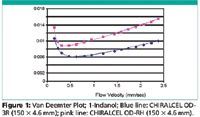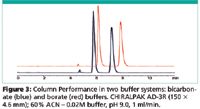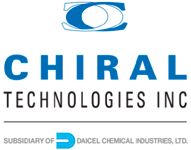Reversed-Phase Enantioselective Chromatography with New µ-mm Chiral Stationary Phases
The Application Notebook
To meet the growing need for fast reversed-phase enantiomer separations, two new 3-μm reversed-phase columns, CHIRALCEL® OD® -3R and CHIRALPAK® AD® -3R, have been introduced. High column performance and column stability under a wide range of conditions, including aqueous solvent systems suited to LC–MS, have been
To meet the growing need for fast reversed-phase enantiomer separations, two new 3-μm reversed-phase columns, CHIRALCEL® OD® -3R and CHIRALPAK® AD® -3R, have been introduced. High column performance and column stability under a wide range of conditions, including aqueous solvent systems suited to LC–MS, have been
Fast chromatography of chiral compounds is receiving increased attention due to the demand to reduce costs and development time. This is especially important for reversed-phase separations which are often carried out at lower flow rates and with longer retention times than in normal-phase chromatography. The introduction of new, 3-μm columns is intended to address these needs for both analysis of aqueous-based samples and for LC–MS applications.

Performance
Columns packed with 3-μm particles can be operated at high flow rates without appreciable loss in their efficiency, thus leading to faster analysis time. The chromatographic performance of the 3- and 5-μm columns were tested using a mixture of solutes, listed in Table I. Van Deemter plots, shown in Figure 1, clearly demonstrate the advantage of using the 3-μm column for fast analysis, if needed.

Figure 1
Stability
Reversed-phase liquid chromatography (RPLC) can give rise to high column pressures due to mobile phase viscosity in addition to use of high pH conditions for certain solutes. Stability of 3-μm columns to the high pressures is critical for their use in such applications. Column stability to pressure was tested by operating the columns at pressure drops across the column beds of 150, 200, and 250 bar over a period of 3 weeks. Table I shows no change in column efficiency (N) over the testing period. Figure 2 demonstrates an efficient separation of the test solutes using CHIRALPAK AD-3R after the stress testing.

Figure 2
High pH operation and LC–MS
Previously it has been demonstrated that the polysaccharide-based columns are generally stable at pH values as high as 9, provided that a buffer system such as sodium tetraborate is used. These conditions are necessary for the RPLC separation of many basic compounds. Use of borate buffers with LC–MS is precluded due to their non-volatility. Stability tests were carried out using a LC–MS-compatible volatile buffer system: ammonium bicarbonate, with pH adjusted to 9 using diethylamine. Figure 3 shows the comparison of the separations of tolperisone enantiomers utilizing the two buffer systems. It is clearly seen that the use of the LC–MS-compatible buffer system did not compromise column stability and column performance.

Figure 3

Chiral Technologies, Inc.
800 North Five Points Rd, West Chester, PA 19380, tel. (800)6-CHIRAL • Website: www.chiraltech.com


.png&w=3840&q=75)

.png&w=3840&q=75)



.png&w=3840&q=75)



.png&w=3840&q=75)














